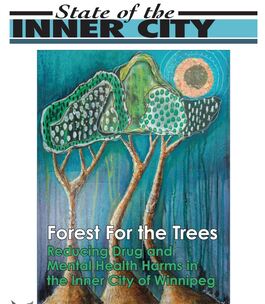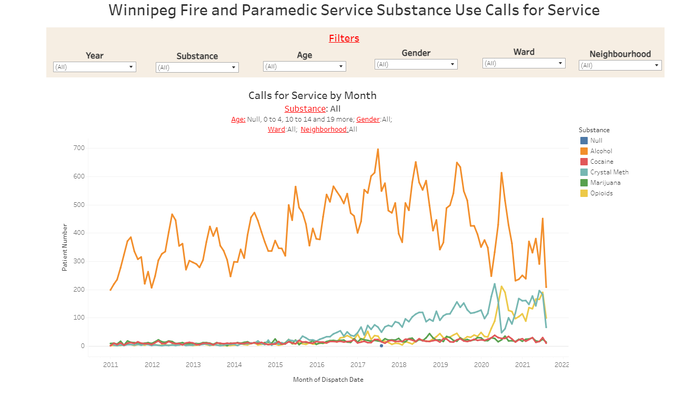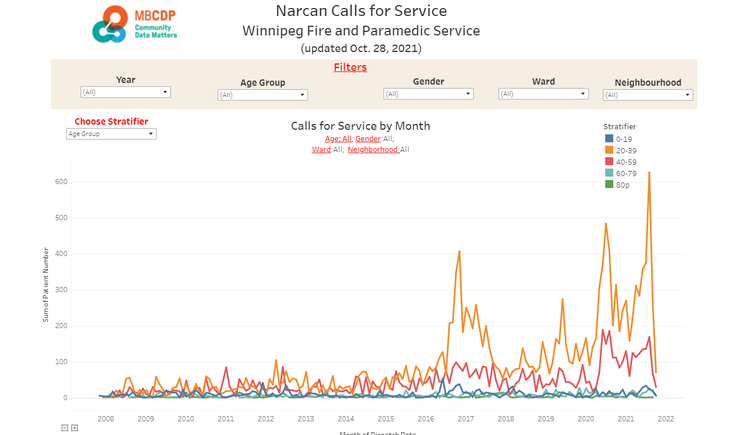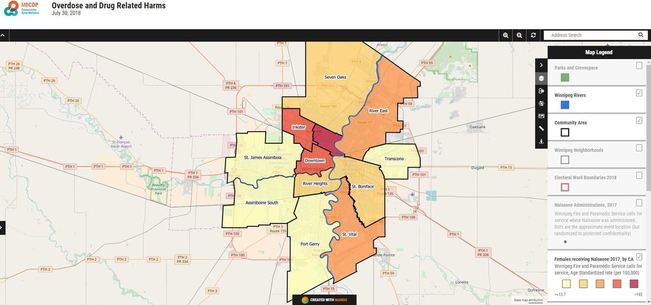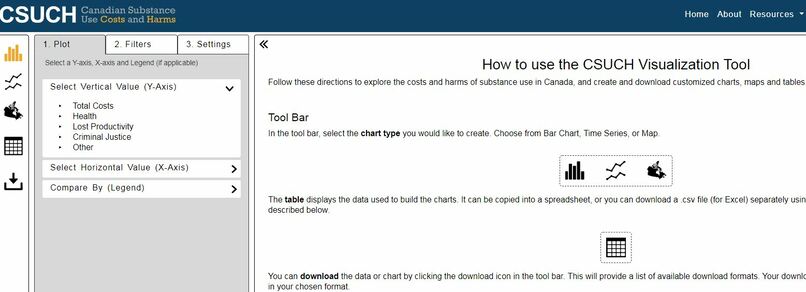Overdose and Drug Related Harms
-
Background and Purpose
-
Reports and Research
-
Interactive Data Tools
-
Community Resources
-
Drug Alerts
<
>
Background and Purpose
The purpose of this portal is to provide an easily accessible knowledge base on Overdose and Drug Related Harms for Winnipeg and for Manitoba as a whole in order to engage and educate the public, and to inform policies and programs.
The portal does not provide any new information that cannot be found elsewhere. It simply provides in one place a convenient set of links to existing statistical reports and community resources.
The portal is being developed in collaboration with local context experts and community stakeholders.
To provide feedback on this portal please connect us via our CONTACT PAGE .
The portal does not provide any new information that cannot be found elsewhere. It simply provides in one place a convenient set of links to existing statistical reports and community resources.
The portal is being developed in collaboration with local context experts and community stakeholders.
To provide feedback on this portal please connect us via our CONTACT PAGE .
Reports and Research
|
Canadian Centre for Policy Alternatives (CCPA)
|
House of Commons Standing Committee on Health Studies (HESA):
- Impacts of Methamphetamine Abuse in Canada: Report of the Standing Committee (June 2019): In April 2019, the House of Commons Standing Committee on Health travelled across the country to witness first hand the impacts of the rise of problematic
methamphetamine use, which is rapidly becoming a public health crisis in some communities.
- The Illicit Drug Task Force Report (June 28, 2019) was authored to identify coordinated strategies to respond to the rapid increase in the distribution and use of methamphetamine and other substances in Manitoba. Three levels of government sponsored the work of the task force that authored the report: Mayor Brian Bowman, City of Winnipeg; Cameron Friesen, Health, Seniors and Active Living Minister; and Robert-Falcon Oullette, Member of of Parliament for Winnipeg Center.
- Virgo Report: The Government of Manitoba, as represented by Minister of Health, Seniors and Active Living commissioned the Virgo report, a strategic plan to identify ways to improve access and coordination of services for individuals with substance use/addiction and mental health problems and illnesses.
- Surveillance of Opioid Misuse and Overdose in Manitoba : These surveillance reports describe opioid misuse and overdose in Manitoba. Aggregate data is collected from a wide range of provincial stakeholders and is used to develop programs and policy around the opioid situation. A baseline report provides data up until the end of 2016. Quarterly reports follow.
- Baseline Report
- Baseline Summary
- 2017 - 1st Quarterly Report (January 1 – March 31, 2017)
- 2017 - 1st Quarterly Report Summary (January 1 – March 31, 2017)
- 2017 - 2nd Quarterly Report (April 1 – June 30, 2017)
- 2017 - 2nd Quarterly Report Summary (April 1 – June 30, 2017)
- 2017 - 3rd Quarterly Report (July 1 – September 30, 2017)
- 2017 - 3rd Quarterly Report Summary (July 1– September 30, 2017)
- 2017 - 4th Quarterly Report (October 1 – December 31, 2017)
- 2017 - 4th Quarterly Report Summary (October 1 – December 31, 2017)
- 2018 - 1st Quarter Report (January 1 - March 31, 2018)
- 2018 - 1st Quarterly Report Summary (January 1 - March 31, 2018)
- 2018 - 2nd Quarterly Report (January 1 - June 30 2018)
- 2018 - 2nd Quarterly Report Summary (Jan 1 - June 30, 2018)
- 2018 - 3rd Quarterly Report (July 1 - Sept. 30, 2018)
- 2018 - 3rd Quarterly Report Summary (July 1 - Sept. 30, 2018)
- 2018 - 4th Quarterly Report (Oct 1 - December 31, 2018)
- 2018 - 4th Quarterly Report (Oct. 1 - Dec. 31, 2018)
- Surveillance of Cannabis in Manitoba: Baseline Report (published Nov. 26, 2018): This report brings together cannabis and related data from a range of sources and stakeholders to provide epidemiological evidence to inform policy and programs in Manitoba.
- Surveillance of Problematic Substance Use and Related Harms in Manitoba
- Reports and Publications:
- Manitoba Cannabis Survey Report (2017)
- Liquor and Gambling in Manitoba (2017)
- Manitoba Longitudinal Study of Young Adults (2016
- National Surveillance of Opioid-related Harms
- National Report: Apparent opioid-related deaths in Canada (released March 2018)
- National Report - Apparent opioid-related deaths in Canada (released June 2018)
- Canadian Substance Use Costs and Harms, 20017-2014: In this new report (released Nov 14, 2018), it is estimated that the overall cost of substance use in Canada was $38.4 billion in 2014, amounting to approximately $1100 for every Canadian regardless of age. In Manitoba it is estimated that substance use is costing the province $1.4 billion annually.
- National Report
- Manitoba Infographic
- Province Specific Costs (summary)
- Province Specific Data (detailed)
- Cannabis use among Canadian Students (March 2019): Data from seven student surveys (including AFM) across Canada contributed to the report. This report provides a baseline snapshot of cannabis indicators in this population before legalization of non-medical cannabis. It is hoped that the findings provide useful information on the gaps that are needed to address our knowledge of youth cannabis use. It is also hoped that the report will inform youth-targeted policies,programs and services, in addition to more improved surveys and tools to continue to monitor this landscape in Canada.
- Preparing the social statistics system for the legalization of cannabis (released Oct, 2018)
- In this special edition of Insights on Canadian Society, Statistics Canada explains how the social statistics system will be be impacted by the legalization of cannabis. The article describes how key indicators such as frequency of cannabis use, quantity used, purpose of use, method of exposure and socio-economic covariates will collected through routine survey instruments such as the Canadian Community Health Survey, Canadian, Tobacco, Alcohol and Drugs Survey (CTADS), the National Cannabis Survey (NC) , the Aboriginal Peoples Survey (APS) and the General Social Survey (GSS) and the Household Spending Survey (HSS).
- Opioid Related Harms in Canada 2018: This report presents data on opioid-related hospitalizations and emergency department (ED) visits. For the first time, the Canadian Institute for Health Information (CIHI) is reporting information on 4 types of opioid harm: opioid poisonings, opioid use disorders, adverse drug reactions and neonatal withdrawal symptoms. Together, these categories provide a comprehensive picture of opioid-related harm in Canada.
- Types of Opioid Harms in Canadian Hospitals: Comparing Canada and Australia 2018: This report compares Canada with Australia and has plenty of Canada-specific data that can inform us of the national landscape with respect to opioid use and harms. Typical indicators are included such as hospitalizations, ED visits, length of stay, age, income etc. There are also statistics on intentional poisoning. Key findings in the report include the following:
- Canada and Australia are seeing different opioid challenges (fentanyl versus heroin) and have different processes in their hospitals, which makes direct comparisons difficult.
- While poisoning is the most severe opioid harm, it is the tip of the iceberg, representing about a third of all opioid harms seen in hospitals and EDs.
- There are 5 distinct opioid harm profiles, indicating that different strategies may be required to tackle the challenges of opioids. These profiles present differently across care settings, including the community, the ED and the hospital. A cross-setting perspective is required.
- Fentanyl is the leading cause of opioid-related deaths outside of hospitals in Canada but most patients who come to hospitals with opioid harms are seen for more commonly prescribed opioids such as codeine, morphine and oxycodone.
- Individuals who use opioids typically use the health care system more frequently than the general population, and they are also more likely to leave care against medical advice.
- Poisoning is more common among younger people, but a larger proportion of resources is spent on older people whose care has been complicated by opioid use.
- Pan-Canadian Trends in the Prescribing of Opioids, 2012 to 2016
- Opioid-Related Harms in Canada (2017)
- Hospitalizations and Emergency Department Visits due to Opioid Poisoning in Canada
- Alcohol Harms in Canada
- Report: Alcohol Harm in Canada: Examining Hospitalizations Entirely Caused by Alcohol and Strategies to Reduce Alcohol Harm
- Interactive Tool: Explore new Hospitalizations Entirely Caused by Alcohol
- CCENDU Winnipeg 200-2012 Report, 2015. This report is a compilation of information from different Winnipeg-based (and some Manitoba-based) agencies that track substance use and abuse (and related) statistics
- Health and Social Outcomes Associated with High-Risk Alcohol Use, 2018, Nickel NC, Bolton J, MacWilliam L, Ekuma O, Prior H, Valdivia J, Leong C, Konrad G, Finlayson G, Nepon J, Singal D, Burchill S, Walld R, Rajotte L, Paille M
- 2017 Annual Statistical Report: The Winnipeg Police Service 2017 Annual Statistical Report shows that crime rates continue to rise in Winnipeg. Violent crime is up by 7%. Property crime by 9%. And drug crime has risen 15%. The report speculates that the reason behind the increase is due in large part to the growing use of methamphetamine and the pattern of violence associated with the illicit drug trade.
- Managed Alcohol Programs in Manitoba: Feasibility Report, 2017
- Safer Consumption Spaces: Winnipeg Consultation and Needs Assessment, 2018
- The Safer Consumption Spaces Working Group has completed a report on the findings of their consultation and needs assessment. The Working Group is a voluntary collective of people from organizations who came together with a common interest in learning from people who use drugs about the spaces of everyday drug use, and the spaces they envision and value.
- Manitoba Youth Health Survey Report
- Winnipeg Health Region Report
- WRHA Access River East Community Area
- WRHA Seven Oaks Community Area
- WRHA Inkster Community Area
- WRHA Point Douglas Community Area
- WRHA Transcona Community Area
- WRHA Downtown Community Area
- WRHA St. James Community Area
- WRHA Downtown Community Area
- WRHA Assiniboine South Community Area
- WRHA River Heights Community Area
- WRHA St. Boniface Community Area
- WRHA Fort Gary Community Area
- WRHA St. Vital Community Area
- At a Glance - Lessons learned from Launching the Manitoba Take-Home Naloxone Program, Songul Bozazt-Emre, Shelley g. Marshall, Colin Zhong, Joss Reimer, in Special Issue: The Opioid Crisis in Canada - Enhancing Knowledge to Support Action, Part 1, Health Promotion and Chronic Disease Prevention in Canada: Research, Policy and Practice, Vol. 38 no. 6, June 2018
- At a Glance - Opioid surveillance: monitoring and responding to the evolving crisis, Kahina Abdesselam, Matthew James Dann, Ramona Alwis, Julie Laroche, Samuel Ileka-Priouzeau in Special Issue: The Opioid Crisis in Canada – Enhancing Knowledge to Support Action, Part II, Health Promotion and Chronic Disease Prevention in Canada, Vol 38, No 9, September 2018
- A Data Infrastructure for Monitoring the Impact of Cannabis Legalization: Data Collection and Linkage Strategies to Inform Health and Social Policy, Nathan Nickel (Principal Applicant), Marcia Thomson, Joss Reimer, Alan Katz, Tracie Afifi, Marni Brownell, Souradet Shaw, Marian Shanahan, James Bolton, Shattuck Ciara, Deepa Singal, funded by CIHR (Catalyst Grant), $98,623 (2017 -2019)
- Consultation and Needs Assessment on Safer Drug Consumption Spaces in Winnipeg, WRHA, Sunshine House and the Safer Consumption Spaces Working Group, funded in part by the Canadian Research Initiative in Substance Misuse (CRISM), Prairie Node, a national project funded by the Canadian Institutes of Health Research (CIHR), $15,000 (2018-2019)
- Tracks: Enhanced Surveillance of Risk Behaviours among People Who Inject Drugs in Canada, with implementation in Winnipeg led by the WRHA, funded by the Public Health Agency of Canada (2018-2019)
Interactive Data Tools
Winnipeg Fire and Paramedic (WFPS) Substance Use Calls for Service
Source: City of Winnipeg Open Data Catalogue
Note: If you pulled data from this dashboard before Nov.18, 2021, please note that the calls for service counts were reported incorrectly (inflated), but have now been corrected.
Source: City of Winnipeg Open Data Catalogue
Note: If you pulled data from this dashboard before Nov.18, 2021, please note that the calls for service counts were reported incorrectly (inflated), but have now been corrected.
Winnipeg Fire and Paramedic (WFPS) Narcan Calls for Service
Source: City of Winnipeg Open Data Catalogue
Note: If you pulled data from this dashboard before Nov.18, 2021, please note that the calls for service counts were reported incorrectly (inflated), but have now been corrected.
Source: City of Winnipeg Open Data Catalogue
Note: If you pulled data from this dashboard before Nov.18, 2021, please note that the calls for service counts were reported incorrectly (inflated), but have now been corrected.
Interactive Mapping Application
Using data previously published in the provincial report "Surveillance of Opioid Misuse and Overdose in Manitoba, Oct. 1 - Dec. 31, 2017", this interactive web-map provides the capacity to dynamically explore the spatial distribution of:
If you haven't used any of the mapping applications in the Manitoba Collaborative Data Portal previously, you can access our Quick Start Guide for Mango Maps which provides guidance on basic map functionality. You can learn about advanced mapping functionality by accessing our User Manuals and Video Tutorials which describe in detail how to use the mapping software.
A Data Dictionary that describes in detail each of they layers used in the map is also available.
To launch the map in your web-browser, click on the map image below.
- Suspected overdose admissions to emergency rooms in the Winnipeg Health Region in 2017, and
- Naloxone administration by the Winnipeg Fire and Paramedic Service in the City of Winnipeg in 2017.
If you haven't used any of the mapping applications in the Manitoba Collaborative Data Portal previously, you can access our Quick Start Guide for Mango Maps which provides guidance on basic map functionality. You can learn about advanced mapping functionality by accessing our User Manuals and Video Tutorials which describe in detail how to use the mapping software.
A Data Dictionary that describes in detail each of they layers used in the map is also available.
To launch the map in your web-browser, click on the map image below.
Online tool for Substance Use Costs and Harms
the costs and harms of substance use and create customized charts and tables using a new interactive data visualization tool
Click on the image below to launch the tool
the costs and harms of substance use and create customized charts and tables using a new interactive data visualization tool
Click on the image below to launch the tool
Tool Description:
Substance use cost the Canadian economy $38.4 billion in 2014. That amounts to approximately $1,100 for every Canadian regardless of age. The Canadian Centre on Substance Use and Addiction, in partnership with the Canadian Institute for Substance Use Research, is pleased to announce the release of an online data visualization tool that will allow users to explore the costs and harms of substance use in Canada by the following categories:
Powered by an extensive set of substance use cost and harm data, the tool allows users to produce compelling, interactive graphics.
Other features:
The tool accompanies previously released resources, including the national report, Canadian Substance Use Costs and Harms (2007-2014), and a provincial and territorial report, Canadian Substance Use Costs and Harms in the Provinces and Territories (2007–2014), allowing for comparisons between provinces and territories and in relation to national estimates.
Substance use cost the Canadian economy $38.4 billion in 2014. That amounts to approximately $1,100 for every Canadian regardless of age. The Canadian Centre on Substance Use and Addiction, in partnership with the Canadian Institute for Substance Use Research, is pleased to announce the release of an online data visualization tool that will allow users to explore the costs and harms of substance use in Canada by the following categories:
- Province or territory
- Year: from 2007 to 2014
- Type of substance, including alcohol, tobacco, cannabis, opioids and other central nervous system (CNS) depressants, cocaine and other CNS stimulants, and other substances such as hallucinogens and inhalants
- Cost category: health, lost productivity, criminal justice and other costs
- Age, sex and health condition (where available)
Powered by an extensive set of substance use cost and harm data, the tool allows users to produce compelling, interactive graphics.
Other features:
- Create bar charts, time series, a map of Canada and tables
- Conduct detailed analysis using filter options
- Customize your bar charts (stacked or side-by-side) or lock the y-axis to do multiple comparisons
- Export and download outputs
- Access the help menu and glossary
The tool accompanies previously released resources, including the national report, Canadian Substance Use Costs and Harms (2007-2014), and a provincial and territorial report, Canadian Substance Use Costs and Harms in the Provinces and Territories (2007–2014), allowing for comparisons between provinces and territories and in relation to national estimates.
Community Resources
Caring for People Who Use Drugs, Winnipeg Regional Health Authority
- Providing safe and inclusive care for people who use drugs starts with non-judgmental engagement. This involves an understanding that most drug use is not problematic. Problematic drug is defined as use that has negative consequences for the individual, their friends, family, and/or society
- This web page provides links to resources, strategies and tools intended to support health care providers and other staff to better meet the needs of people who use drugs.
- Street Connections is a mobile public health service. The goal of Street Connections is to reduce the spread of sexually-transmitted and blood-borne infections (STBBIs), including hepatitis C and HIV, and reduce other drug-related harms.
- Street Connections is part of Healthy Sexuality and Harm Reduction in the Winnipeg Regional Health Authority's (WRHA) Population and Public Health Program.
- Public health nurses and outreach workers staff the Street Connections van, which drives around the city every evening except Sunday. You can also find Street Connections services during the day from Monday to Friday in our office on the main floor of 496 Hargrave St.
- Street Connections bases their services on a harm reduction philosophy. This means that Street Connections supports programs and policies that improve the health of people who use drugs and support people in their efforts to keep themselves and the larger community safe, without judging people for their sexual or drug use practices.
- AFM is a Crown agency that is committed to being a foundation of excellence in providing addictions services and supporting healthy behaviours. AFM employs over 400 staff and provides a wide range of addictions services to Manitobans through 28 locations across the province
- This site provides a a set of links to a wide range of resources and services relevant to mental health and addictions in Manitoba
Drug Alerts for Winnipeg
WRHA Population and Public Health Winnipeg Drug and Overdose Alerts is a process designed to communicate information about emerging health risks related to the use of illegal drugs. Alerts are intended to reach people who use drugs by way of programs and services that serve them. If you wish to receive these alerts please follow the link at the bottom of this page.
There are three main sources of information that inform the alerts:
There are three main sources of information that inform the alerts:
- Overdose Alerts: When Winnipeg Fire and Paramedic Services experience abnormally high numbers of opioid overdose response calls in the previous 12 to 24 hours, an alert will be sent to recipients. This includes both increased numbers of opioid overdoses requiring naloxone administration, and opioid overdoses that require unusually high quantities of naloxone to reverse.
- Drug Alerts: The WRHA provides drug alerts from Winnipeg Police Service or RCMP when a street drug is confirmed to contain potentially harmful components, such as powerful opioid drugs or other life threatening substances.
- Other: May include detection of powerful opioid (fentanyl or analogues) through toxicology reports, or other sources that may indicate a potential increased risk of overdose or other drug harms.
